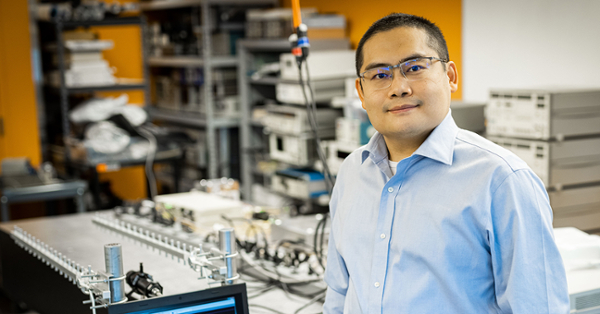Rowan University engineering team aims to improve communications spectrum
Rowan University engineering team aims to improve communications spectrum

For those who have ever complained that they couldn’t send a text message or play a video game while in a crowd—say, at a festival—a Rowan University engineering team is aiming to solve the problem.
Dr. Ben Wu, an assistant professor of electrical and computer engineering at the Henry M. Rowan College of Engineering, has been awarded a $300,000 grant from the National Science Foundation to create a new wireless communication system in collaboration with Princeton University and Rutgers.
Over the years, as more people utilized smartphones for gaming, downloading data, and streaming—in addition to traditional calls and texts—the existing spectrum became clogged with interference, resulting in slow load times and difficulty connecting calls.
“It’s a long-existing problem and it’s getting worse,” said Wu, the lead principal investigator on the project. “People want more communication, people want more data. Everyone wants a higher speed.”
Wu likens the existing radio frequency spectrum to a cake, but only one slice is left for a dozen hungry partygoers. His solution is to provide each person with their own slice of cake, by creating new resources with a photonic circuit, which uses light instead of electricity to process informational signals.
“Your home uses the existing spectrum,” Wu said. “What I’m doing is using optical methods to bring new resources to the existing spectrum.”
To do that, Wu and his team must develop new hardware. This requires creating new circuits where signals will be transmitted through a photonic circuit instead of electric wires. Photonic circuits can process signals at the speed of light, which is much faster than the existing methods.
Last year, engineering doctoral student Yang Qi created a prototype over the course of a few months for these circuits in order to test if the new communication system would work. The results were promising: Messages were sent and received clearly.
“I was pretty excited,” Qi said. “I heard Dr. Wu explain his idea and that was pretty phenomenal, but I still had questions whether it was going to work or not. When the results came out, I was super thrilled.”
The next phase of the research is to fine-tune the prototype, making it more efficient and compact, and then to test it on hundreds of users all using the spectrum at one time.
If successful, “this can be a game changer for the future of optical communications,” said Dr. Robi Polikar, who heads Rowan’s Department of Electrical & Computer Engineering.
“We want future communications networks to use this technique,” Wu said. “It could be the future sixth-generation communication network.”